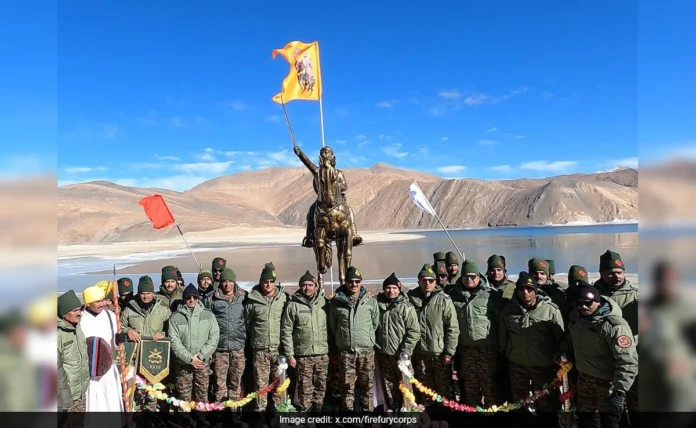The Statue of Chhatrapati Shivaji has been unveiled by the Indian Army near the Line of Actual Control (LAC) with China in the eastern Ladakh sector, at the banks of Pangong Lake. The statue stands tall at an altitude of 14,300 feet, celebrating the legacy and spirit of the legendary Maratha warrior.
Symbol Of Valour At The Border
Unveiled by Lt Gen Hitesh Bhalla, General Officer Commanding the 14 Corps, also known as the Fire and Fury Corps, the statue is seen as a towering symbol of bravery and justice. The Leh-based 14 Corps shared on X, “The event celebrates the unwavering spirit of the Indian ruler, whose legacy remains a source of inspiration for generations.”
The Indian Army has emphasized integrating India’s ancient strategic wisdom into modern military practices. The unveiling marks another step in showcasing the historical narratives that have guided India’s resilience and courage.

Strategic Significance Of The Statue’s Location
Pangong Lake, located near the India-China border, has been a significant point of contention in recent years. The installation of the Statue of Chhatrapati Shivaji comes weeks after India and China finalized the disengagement process at two critical friction points, Demchok and Depsang, ending a standoff that lasted over four years.
The standoff began in May 2020 with a violent clash at the north banks of Pangong Lake, escalating tensions between the two nations. Following extensive diplomatic and military dialogues, disengagement at Pangong’s north and south banks was achieved in 2021. The recent resolution at Demchok and Depsang marks a significant milestone in maintaining peace and stability in the region.
Legacy Of Chhatrapati Shivaji Maharaj
The installation of the statue pays tribute to Chhatrapati Shivaji Maharaj, one of India’s most revered rulers known for his military acumen, administrative skills, and vision for justice. Born in 1630, Shivaji was the founder of the Maratha Empire and played a pivotal role in resisting Mughal domination in India. His strategies and governance are often cited as examples of excellent statecraft.
Placing the statue in a region close to the LAC signifies the Indian Army’s effort to draw inspiration from Shivaji’s unwavering determination and courage, especially in guarding the nation’s borders.

A Landmark In India-China Relations
The unveiling of the statue coincides with a turning point in India-China relations, where efforts to de-escalate border tensions have seen positive outcomes. Since the violent clashes in May 2020, both nations have engaged in several rounds of talks, leading to phased disengagement at critical points of conflict.
However, the installation also symbolizes India’s firm stance on border sovereignty and its commitment to defending its territorial integrity. Pangong Lake, now home to Shivaji’s legacy, serves as a reminder of India’s resilience and vigilance at its borders.
India’s Push To Integrate History Into Modern Defense
The Indian Army’s initiative to install the Statue of Chhatrapati Shivaji aligns with its broader vision to merge India’s historical narratives with its contemporary defense strategies. The Army’s Leh-based Fire and Fury Corps has been actively promoting cultural and historical initiatives to strengthen morale and integrate traditional wisdom into modern practices.
By celebrating Shivaji’s legacy in a region of strategic importance, the Indian Army sends a strong message of its commitment to preserving the nation’s history while adapting to current challenges.
This installation is not just a symbol of pride but also a statement of inspiration for the soldiers defending the borders under challenging conditions. It reflects the spirit of resilience, much like Shivaji Maharaj, whose strategies and bravery continue to resonate in India’s history.
The statue’s placement at Pangong Lake, with its turbulent history of conflicts and peace negotiations, stands as a testament to India’s resolve to honor its heroes while protecting its sovereignty.

